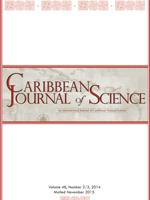The spatial and temporal variability in mean prevalence of Caribbean yellow band disease (CYBD) in the scleractinians Orbicella faveolata and O. franksi was assessed during 2008 and 2009 in reefs off La Parguera, Puerto Rico. All diseased and healthy-looking colonies were counted along each of four band transects (20 m2) in each of 3 depth intervals (3–8; 8–15; > 15 m) in two inner (Pelotas and Enrique) and two mid-shelf (Turrumote and Media Luna) fringing reefs, and two deep bank reefs at the shelf-edge (Weinberg and Old Buoy). Overall, densities of O. faveolata were higher at intermediate depth habitats (0.5 col./m2) while those of O. franksi were higher at deep habitats (1.7 col./m2). In inner-and mid -shelf fringing reefs both O. faveolata and O. franksi showed significantly higher mean CYBD prevalence at intermediate depth habitats (25 ± 24 % and 17 ± 36 %) compared to deeper (13.4 ± 27 % and 5.2 ± 11 %) and shallow habitats (7.9 ± 11 % and 0 %, respectively). Mean CYBD prevalence in O. faveolata and O. franksi were significantly higher (p<0.05, H=31.6; df=2; U=1756; p<0.05) in mid-shelf reefs (28 ± 27 % and 16.3 ± 31 % respectively) compared to shelf-edge reefs (5.3 ± 5.6 % and 1 ± 1.4 %) and to inner-shelf reefs (9.9 ± 20.6 %) only for O. faveolata. There was a significant positive correlation between CYBD prevalence and densities of O. faveolata (Spearman's r = 0.7; p<0.05). In contrast, O. franksi showed a significant but negative correlation (Spearman's r = -0.5; p<0.05). No significant change in mean CYBD prevalence was observed between seasons and years (2008 to 2009) for both species (26.9 ± 24.9 % and 24.1 ± 23.4 % in O. faveolata and 5.4 ± 10.7 % and 5.0 ± 12 % 5.4 ± 10.7 % to 5.0 ± 12 % in O. franksi respectively). Overall, O. faveolata had significantly higher CYBD prevalence compared to O. franksi which indicates that this species is more susceptible to CYBD. Deep habitats with low quality/quantity of light might serve as a refuge from CYBD in both species. The slight decrease over time in the proportion of infected colonies in both species, indicates no new infections, possibly because of lack of more susceptible colonies after 12 years, reduced virulence, an immune response, or any combination of these.
How to translate text using browser tools
1 January 2014
Spatial and Temporal Variability of Caribbean Yellow Band Disease Prevalence in Orbicella spp. off La Parguera, Puerto Rico
Francisco J. Soto-Santiago,
Ernesto Weil
ACCESS THE FULL ARTICLE

Caribbean Journal of Science
Vol. 48 • No. 2–3
2014
Vol. 48 • No. 2–3
2014
Caribbean yellow band disease
Coral
prevalence
temperature
zooxanthellae




